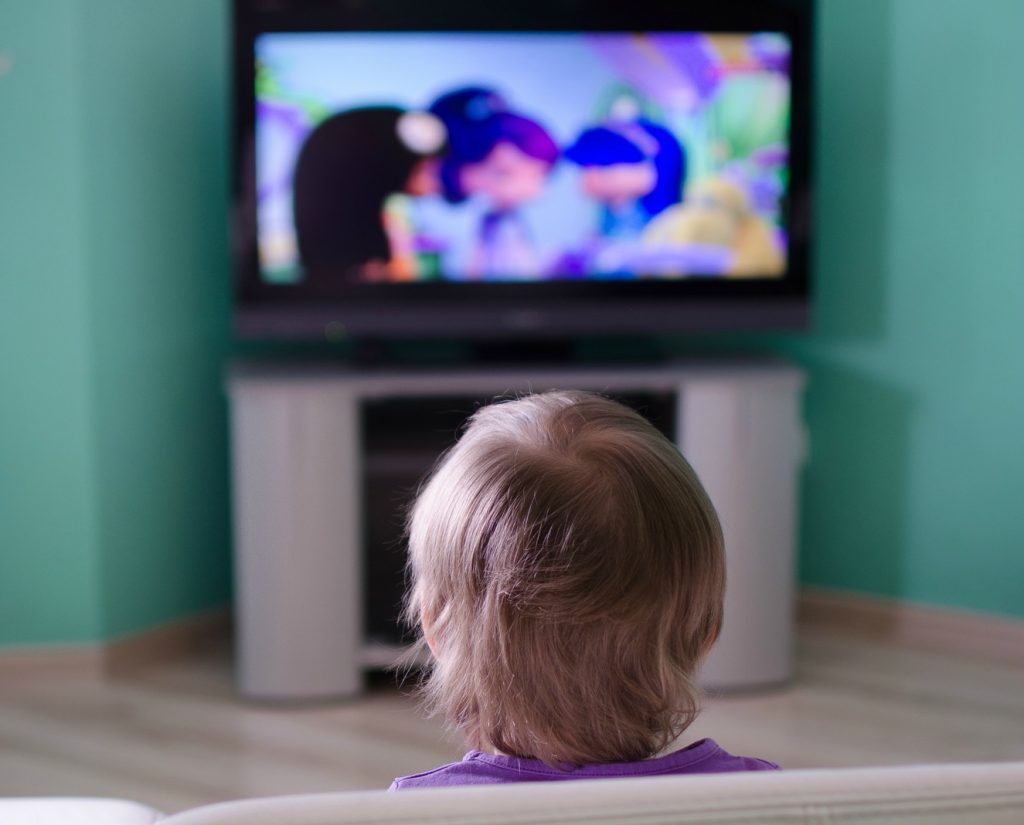How Limiting My Toddler’s TV Time Made Me a More Productive Mom
This post is part of a series on setting boundaries with technology that will bless your home life. See more here.

My daughter watched her first TV show at 18 months old. I found The Hungry Caterpillar on Netflix, and she was smitten! I was smitten too: It bought me a precious 30 minutes without a toddler at my feet. Soon, I allowed a morning and afternoon “TV time” each session creeping up to an hour. It seemed harmless, and in many ways it was. I am a work-from-home mom running my own business, so much of my work is done in the fringe hours of the day. Buying a few more minutes with a Netflix show seemed like a great way to save on a babysitter.
While pregnant with my second daughter, Susan Yates recommended the book The Tech Wise Family by Andy Crouch. I bought it – and read it – immediately. What I found was convicting. The book explained how invasive technology really is, and it made me think about my own childhood. My parents didn’t have cable television until after I graduated and left the house. I got my first phone at seventeen years old. My memories are full of people and experiences – not movies, TV shows, and screens.
I want this for my daughters. But at the time, I was caught between a desire to cultivate healthy tech boundaries and my need to be productive. Can I have both? I wondered.
I discovered that I can – and so can you! Limiting my toddler’s TV time has made me MORE productive and helped me enjoy my children more. Here’s what I’m learning through this journey (because with an almost three-year-old and a nine-month-old, I’m still in the throes of it!):
The Catch-22 of TV
We put our toddlers in front of the TV because it’s a quick way to catch a break. There’s nothing inherently wrong with this, but when it becomes a pattern – a way to hide from our own children – we’re not dealing with the real issue at hand. I certainly wasn’t. Television was my short-term solution to frustration, lack of purpose, and even anger. Though it gave me a 30-60 minute break, the long-term effects on my family were not positive.
Adeline learned to beg for the television. The more she begged, the more frustrated I became, and the more likely I was to give in. This created an unhealthy parenting pattern, which ended either with her getting what she wanted (affirming that whining is okay) or me timing her out in frustration.
I learned to build my schedule around the TV. I found myself waiting for the moment I could turn it on and get away from my child. I didn’t enjoy her; I managed her. As someone who loves to work, I unconsciously viewed Adeline as an inconvenience to my work schedule.
I didn’t think about incorporating her into my work or teaching her how to entertain herself with something other than a screen. She seemed too young, plus – she slowed me down.
While TV time seemed like the way to get housework done or find 30 minutes of free time, the long-term effects on my family – and my heart – were not God’s best for our family.
This post may contain affiliate links through which Club31Women might get a small compensation – with no additional cost to you. See my disclosure policy here.
Healthy Tech Boundaries Forced Me to Face my Priorities
After reading The Tech Wise Family, we didn’t get rid of our television. We still let Adeline watch shows. So what changed? Our view of technology and my boundaries in using it. Before, I’d play my favorite show to have noise in the house while I worked. Then I’d plop Addie in front of the TV to write an article or clean the living room. I knew I wanted to engage with her but still needed to manage my home, make three meals a day, host our small group, and manage my business. So we made some changes:
- We moved the TV out of the living room and into the bedroom. For four years we had avoided “TV in the bedroom” because we’d heard it was bad for marriages. However, we found we connected over our favorite shows and were more intentional about what we watched when the TV was relegated to a separate room in the house.
- I divided my tasks between “things I can do with Addie” and “things I can’t do with Addie”. In the first list were things like dishes, laundry, putting away clothes, and cleaning the room of the day. More focused tasks like big house projects, articles, and business work had to wait. By involving her in household management, she learned to help. I learned patience. And I saved the television for times when I actually needed it instead of using it to assuage frustration.
- I learned to deal with my frustration as the spiritual problem it was (and is). Rather than turn on the TV to get a break, I put Adeline in her crib with some books for “quiet time” and used that time to pray or read the Word. This broke the cycle of dependency and obsession for both me and Adeline.
- We have never allowed our girls to use phones or iPads, and this has been very positive when outside the house. Without dependency on distraction, they engage with the people around them in the grocery store, coffee shop, or car.
These changes not only helped my toddler engage more with real life, they helped me get more done around the house. I am much more intentional with my to-do list. I get more done in a shorter time, even though I often have my littles alongside me! The initial few weeks (and some days here and there) are hard, but the investment is worth it.
It’s counterintuitive, but it works. And it doesn’t work just because you take television away; it works because it changes how we think and mother. Removing the television as a babysitter frees us to be more intentional with our kids and our time. We feel more involved, we become more efficient, and we teach our kids what it means to contribute to the family from a young age.
I highly recommend reading The Tech Wise Family and coming up with technology boundaries of your own. As children age, boundaries have to change, but if your priorities are consistent, you’ll find a system that works for your family.
If you need help creating routines and systems to become more productive as a mom – with or without television! – my free, 8-day productivity course is for you! Hundreds of women have been through this email-based course and saw change as quickly as the second day. Enroll here!
Blessings,

100 Words of Affirmation Your Son/Daughter Needs to Hear
Matt and Lisa Jacobson want you to discover the powerful ways you can build your children up in love with the beautiful words you choose to say every day–words that every son and daughter needs to hear.
These affirmation books offer you one hundred phrases to say to your son or daughter – along with short, personal stories and examples – that deeply encourage, affirm, and inspire.
So start speaking a kind and beautiful word into their lives daily and watch your children–and your relationship with them–transform before your eyes.






